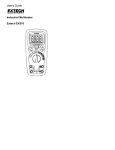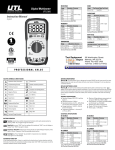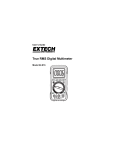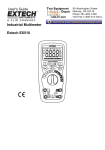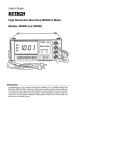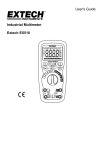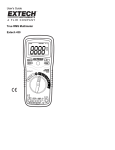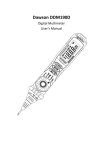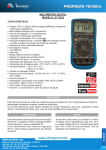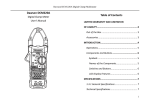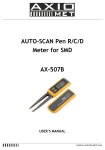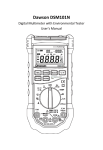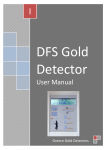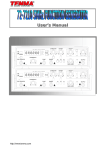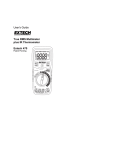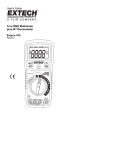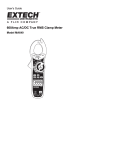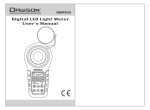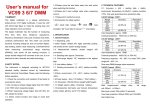Download User Manual
Transcript
DIGITAL MULTIMETER DDM453 / DDM453 SERVICE Thank you for purchasing our product! As our customers are our top priority and we strive for 100% satisfaction, we would appreciate your feedback on the product. Please contact our customer service department at (310) 728-6220 or at www.dawsontools.com if you have any questions regarding this product. Our professional support team is always ready to answer your enquiries and provide assistance. 00-05-3843 6 CAT.III 600V LIMITED WARRANTY AND LIMITATION OF LIABILITY 1. This instrument from Dawson Tools Inc. will be free from defects in workmanship and material for three years from the date of original purchase. This warranty does not cover defects resulting from damage caused by the user such as drops, neglect, misuse, unauthorized alteration, usage outside of specified conditions, contamination, or improper repair/maintenance. To receive service on the instrument if it becomes necessary during the warranty period, contact your nearest Dawson authorized service center at (800) 898-6991 or visit www.DawsonTools.com to obtain a return authorization (within the US only). A return authorization is necessary before returning anyinstrument to Dawson; no service will be provided without a return authorization. The user is responsible for properly packing the unit and charges such as shipping, freight and insurance charges. The extent of Dawson's liability is limited solely to the repair/replacement of the instrument. The above warranty in Its entirety is inclusive and no other warranties, written or oral, are expressed or implied. Out of the Box Check the meter and accessories thoroughly before using the meter. Contact your local distributor if the meter or any components are damaged or malfunction. Accessories • Test leads • User's manual • 9V battery • Type-K Thermocouple x1 pair x1 x1 x1 1 INTRODUCTION DDM453 is a stable, safe, reliable compact digital handheld 6000 count auto-ranging multimeter. This meter can measure AC/DC voltage, AC/DC current, resistance, capacitance, frequency, duty cycle, temperature, diodes and continuity. This meter is ideal for many situations, whether you're a professional or causal user. 2. WARNINGS To avoid electric shock and injury or damage to the meter, observe the following safety methods: • Check the meter before use to make sure there was no damage during transit. • Check that the insulation on the test leads is not damaged and/or wires are not exposed. • If any faults or abnormalities are observed, the meter should not be used and should be checked out prior to use. • Never exceed the protection limit values indicated in specifications for each range of measurement. • Always be careful when working voltages above 60V DC or 30V AC rms, keep fingers behind the probe barrier while measuring. • Make sure the rotary switch is in the correct position before measurement. • Never use the meter in an environment with explosive gas, vapor or dust. • Always keep fingers behind probe barriers when making measurements. • When connecting test leads to a circuit, connect the black test lead first, then the red lead. Disconnect in the opposite order. • Turn off power and discharge all capacitors first before measuring resistance, continuity or diodes. • Failure to follow safety guidelines could compromise the safety features of this meter. • Do not use the meter without the battery cover in place. • Replace the batteries as soon as the low battery symbol appears “ ” to avoid false reading that could lead to electric shock and injury. • Remove test leads from all circuits before opening the battery cover. 2 SAFETY SYMBOLS 3. Important safety information Ground AC(alternating current) Double insulation protection DC(direct current) Fuse DC/AC Voltage or Current Compliance with EU regulations FEATURE DETAILS 4. 1 4 2 DDM453 3 5 / 1.LCD Display 2.Hold/Backlight Button Press “ ” to hold the current reading on the display. Press the button again to release the hold. Hold “ ” to turn on the backlight. Hold the button again to manually turn off the backlight. 3.Function Button Press “FUNC” to switch between functions or between AC/DC current. 4.Frequency/Duty Cycle Button (Hz/%) In AC voltage/current modes, press “Hz%” and the display will show the frequency measurement. Press the button again to switch to duty cycle. Press the button a third time to return to normal display.With the rotary switch in the Hz/% position, the default mode is frequency. Press the "Hz/%" button to show the duty cycle. Press the button again to switch back to frequency display. 5.NCV Button Hold the “NCV” button down in any mode and the meter will activate the non-contact voltage detection. Move the top of the meter towards an AC voltage source and the buzzer will sound and the NCV indicator will light up if voltage is detected. Release the “NCV” button to stop NCV detection. 6.Rotary Switch 7.Input Jack (all measurements; current below 600mA) 8.A Jack (current measurements between 600mA-10A only) 9.Common Jack (all measurements) 6 7 8 6 9 3 4 DISPLAY DESCRIPTION 5. 4 5 6 7 8 ROTARY SWITCH FUNCTIONS 6. 6 9 7 9 8 1 3 10 2 11 5 4 2 3 1 12 13 1. DC Voltage:<600V 1 Alternating Current 10 Duty Cycle Mode 2 Negative DC Value 10 Temperature in Celsius Direct Current 10 Temperature in Fahrenheit 11 Resistance 3 4 Low Battery 5 Auto Power Off 11 Frequency 6 Auto Range Active 12 Capacitance 7 Data Hold 12 DC/AC Current 8 Diode Test 12 DC/AC Voltage 9 Continuity Test 13 Main Display 6 DDM453 / 1.Turn rotary switch to DC voltage position. 2.Connect leads across voltage source/load. 3.Read voltage measurement on the display. 2. AC Voltage:<600V V 6 DDM453 / 1.Turn rotary switch to AC voltage position. 2.Connect leads across voltage source/load. 3.Read voltage measurement on the display. 5 6 4.2 AC Current (Medium):<600mA 3.1 DC Current (large):<10A 6 6 DDM453 DDM453 / / 1.Turn rotary switch to mA position. 2.Press FUNC to select DC or AC current. 3.Connect leads in series to circuit. 4.Read current measurement on the display. 5.For frequency/duty cycle display, press Hz/%. 1.Turn rotary switch to A position. 2.Press FUNC to select DC or AC current. 3.Connect leads in series to circuit. 4.Read current measurement on the display. 3.2 AC Current (large):<10A 5.1 DC Current (Small):<6000µA 6 DDM453 / 6 DDM453 / 1.Turn rotary switch to A position. 2.Press FUNC to select DC or AC current. 3.Connect leads in series to circuit. 4.Read current measurement on the display. 1.Turn rotary switch to µA position. 2.Press FUNC to select DC or AC current. 3.Connect leads in series to circuit. 4.Read current measurement on the display. 5.2 AC Current (Small):<6000µA 4.1 DC Current (Medium):<600mA 6 DDM453 / 6 DDM453 / 1.Turn rotary switch to mA position. 2.Press FUNC to select DC or AC current. 3.Connect leads in series to circuit. 4.Read current measurement on the display. 7 1.Turn rotary switch to µ A position. 2.Press FUNC to select DC or AC current. 3.Connect leads in series to circuit. 4.Read current measurement on the display. 5.For frequency/duty cycle display, press Hz/%. 8 6.1 Resistance:<60MΩ 7. Capacitance: <60mF 6 6 DDM453 DDM453 / 1. Turn rotary switch to multifunction position. 2. Resistance is the default mode. 3. Connect leads across circuit. 4. Read resistance measurement on the display. / 1.Turn rotary switch to the capacitance position. 2.Connect leads across voltage source/load. 3.Read voltage measurement on the display. 8. Temperature: -20°C~1000°C/-4°F~1832°F 6.2 Continuity: 6 DDM453 / 6 DDM453 / 1.Turn rotary switch to multifunction position 2.Press FUNC to switch to continuity mode 3.Connect leads across circuit. 4.If measured resistance is less than 50Ω, the buzzer will sound. 6.3 Diode Test: 1.Turn rotary switch to the TEMP position. 2.Press FUNC to select Fahrenheit or Celsius. 3.Touch tip of thermocouple to the test object. 4.Read measured temperature on the display. 9.1 Frequency:<10MHz 6 DDM453 / 6 DDM453 / 1.Turn rotary switch to multifunction position. 2.Press FUNC to switch to diode mode. 3.Connect INPUT lead to anode (+) and COM lead to cathode (-). 4.Read measured forward-biased voltage drop. 9 1.Turn rotary switch to the Hz/% position. 2.Frequency is the default mode. 3.Connect leads across circuit. 4.Read measured frequency on the display. 10 9.2 Duty Cycle:<99% 7. 6 DDM453 / 1.Turn rotary switch to the Hz/% position. 2.Press Hz/% to select duty cycle. 3.Connect leads across circuit. 4.Read measured duty cycle on the display. 11. Non-Contact Voltage Detector: NCV DDM453 / DD M4 53 / 1.In any mode, hold the NCV button down. 2.Move the top of the meter toward voltage source 3.If AC voltage is present, NCV indicator flashes/buzzer beeps. Specifications • Operating Altitude: 2000m • Relative Humidity: 75% max operating • Operating Temperature: 0°C~40°C/32°F~104°F (<80% RH) • Storage Temperature: -10°C~60°C/14°F~140°F (<70% RH) • Accuracy Temperature: -18°C~28°C/64°F~82°F (<80% RH) • Temperature Coefficient: 0.1x(specified accuracy)/°C (<18°C or >28°C) • Sampling Frequency: approx. 3 times/sec. • Fuse Protection: µA/mA input: FF 600mA H 600V 10A input: FF 10A H 600V • LCD Display: 6000 count display (5999 max reading) • Power Supply: 9V battery • Dimensions: 150mm×74mm×48mm / 6.3"×2.9"×1.9" • Weight: 8.9oz/250g • Safety Rating: CAT III 600V • Safety Standards: IEC61010-1 • Pollution Degree: 2 • Accuracy: ±(of reading + # of least significant digits) 7. ELECTRICAL SPECIFICATIONS DC Voltage Measurement Range Resolution 600mV 6V 60V 600V Accuracy 0.1mV 0.001V 0.01V 0.1V ±(0.5% of reading +2 digits) • Input impedance: 10MΩ • Max. input voltage: 600V rms 11 12 AC Voltage Measurement Range Resolution 6V 60V 600V Accuracy 0.001V 0.01V 0.1V ±(1.0% of reading +5 digits) • Input impedance: 10MΩ • Max. input voltage: 600V rms • Frequency response: 40~400Hz, calibrated to rms of sine wave (average response) DC Current Measurement Range Resolution Accuracy 600µA 0.1µA 6000µA 1µA ±(1.0% of reading +5 digits) 60mA 0.01mA 600mA 0.1mA ±(2.0% of reading +8 digits) 10A 10mA • Overload protection: µA/mA input: Fuse(FF 600mA H 600V) 10A input: Fuse (FF 10A H 600V) • Max. input current: µA/mA input: 600mA rms 10A input: 10A rms AC Current Measurement Range Resolution Accuracy 600µA 0.1µA 6000µA 1µA ±(1.2% of reading +5 digits) 60mA 0.01mA 600mA 0.1mA ±(2.0% of reading +8 digits) 10A 10mA • Overload protection: µA/mA input: Fuse(FF 600mA H 600V) 10A input: Fuse (FF 10A H 600V) • Frequency response: 40~400Hz, calibrated to rms of sine wave (average response) • Max. input current: µA/mA input: 600mA rms 10A input: 10A rms Resistance Measurement Range Resolution 600Ω 6kΩ 60kΩ 600kΩ 6MΩ 60MΩ Accuracy 0.1Ω 0.001kΩ 0.01kΩ 0.1kΩ 0.001MΩ 0.01MΩ ±(0.7% of reading +3 digits) • Max. input voltage: 600V rms Continuity Test Description Resolution If measured resistance is greater 0.1Ω than 50Ω,the meter's buzzer will sound • Overload protection: 600V rms • Open circuit voltage: ~1.0V DC 13 14 Diode Test Resolution 0.001V Description Display shows the forward-biased voltage drop of the diode. • Overload protection: 600V rms • Open circuit voltage: ~3.2V DC • Test current: ~ 1.0mA Capacitance Measurement Range Resolution 10nF 100nF 1µF 10µF 100µF 1mF 10mF 100mF Accuracy 0.01nF 0.1nF 1nF 10nF 100nF 1µF 10µF 10µF ±(4.0% of reading +5 digits) • Max. input voltage: 600V rms Frequency (AC voltage) Range Resolution Accuracy 99.99Hz 0.01Hz ±(1.5% of reading +5 digits) 999.9Hz 0.1Hz 9.999kHz 0.001kHz Reference only >10kHz 0.01kHz • Signal input range: ≥0.2V AC rms (voltage input will increase as frequency increases) • Input impedance: 10MΩ • Max. input voltage: 600V rms 15 Frequency (AC current) Range Resolution Accuracy 99.99Hz 0.01Hz ±(1.5% of reading +5 digits) 999.9Hz 0.1Hz Reference only >1kHz 0.001kHz • Signal input range: µA: ≥60µA rms mA: ≥6mA rms A: ≥0.6A rms (current input will increase as frequency increases) • Max. input current: 10A rms Frequency (Hz) Range 9.999Hz 99.99Hz 999.9Hz 9.999kHz 99.99KHZ 999.9KHZ 9.999MHZ Resolution 0.001Hz 0.01Hz 0.1Hz 0.001kHz 0.01kHz 0.1KHz 0.001MHz Accuracy ±(1.5% of reading +5 digits) • Signal input range:≥2V AC rms(voltage input will increase as frequency increases) • Max. input voltage: 600V rms Duty Cycle Range Accuracy Resolution 1 – 99% 0.1% ± 2.0% • In current mode: Signal input range: µA: ≥60µA rms mA: ≥6mA rms A: ≥0.6A rms (current input will increase as frequency increases) Max. input current: 10A rms • In voltage mode: Signal input range: ≥0.6V AC rms (voltage input will increase as frequency increases) Input impedance: 10MΩ Max. input voltage: 600V rms 16 Temperature Measurement Range Resolution Accuracy ±(2.0% of reading +2 digits) ±(2.0% of reading +4 digits) 10. WARNINGS -20°C~1000°C 1°C -4°F~1832°F 1°F • Overload protection: Fuse (F600mA/600V) 8. 9. To avoid false reading that could lead to injury or damage to the meter, replace the batteries as soon as the “ ” symbol appears. Turn off the meter and remove the test leads before opening the battery cover to avoid injury or damage to the meter. MAINTENANCE This section provides basic maintenance principles, including replacing batteries and fuses. Do not attempt to repair or perform any maintenance on the meter not included in the section below unless you are qualified personnel. CLEANING WARNING To prevent injury or damage to the meter, do not allow moisture inside the casing. Before opening the battery cover/case, disconnect test leads from all circuits. Clean the meter regularly with a damp cloth and a small amount of detergent; do not use abrasives or solvents. Dirty/wet input jacks can affect readings. To clean input jacks: 1. Turn off the meter and remove test leads. 2. Brush off any dirt or contaminants from the input jacks. 3. Use a cotton swab with a cleaner/lubricant (i.e. WD40) to clean the input jack. 4. Use a new swab on each jack to prevent cross contamination. REPLACING THE BATTERY To replace the battery: 1. Turn off power to the meter. 2. Remove test leads from input jacks. 3. Loosen the screw on the battery cover and remove cover from meter. 4. Replace used battery with a new one. 5. Replace battery cover and secure to meter. 11. REPLACING THE FUSES WARNING To prevent injury or damage to the meter, turn off power to the meter and disconnect test leads from input jacks before opening case. To replace the fuses: 1. Turn off power to the meter. 2. Remove test leads from input jacks. 3. Remove the 6 screws on the back case and remove back case from meter. 4. Replace blow fuse(s) with new fuses of the same electrical ratings (see specifications). 5. Replace back cover and secure to meter. 12. DISPOSAL / RECYCLE Caution: This symbol indicates that equipment and its accessories shall be subject to a separate collection and correct disposal. 17 18










